Abstract
A resistive room-temperature ammonia sensor has been developed by CuBr impregnation of a mesoporous SiO2 host prepared by the sol–gel process and deposited by dip-coating. The mesoporous sensor performances are compared with those of a single CuBr layer. The CuBr encapsulation in a mesoporous host leads to an impressive sensitivity improvement with sub-ppm detection of ammonia at room temperature. The results open new perspectives for the development of highly sensitive chemical sensors and are of great interest for non-invasive health monitoring.
1. Introduction
This work aims to develop an ammonia gas sensor based on copper bromide (CuBr) for medical applications. The transdermal ammonia rate (≈100–1000 ppb) is related to the ammonia amount in the blood [1] and is higher in people suffering from chronic kidney disease. The detection of skin-emitted ammonia as a biomarker would allow non-invasive medical monitoring and improve patients’ comfort and health. We used CuBr as it is an ionic conductor known to react by specific complexation with ammonia at room temperature [2]. In order to enhance its sensitivity, we encapsulated CuBr nanograins in a mesoporous silica thin film. The sensor exhibits very high NH3 sensitivity compared to a CuBr single layer.
2. Materials and Methods
Both sensitive layers were deposited on a Si/SiO2 substrate with Pt interdigitated electrodes. The CuBr layer is prepared from a 3wt% CuBr solution in acetonitrile and deposited by dip-coating. The 90 nm thick mesoporous host layer is prepared by sol–gel synthesis from a solution of TEOS (silica precursor) and Pluronic F127 (pore templating agent). The layer is deposited by dip-coating and calcined at 450 °C for 15 min. The layer is then immerged in a 1wt% CuBr solution and removed at 1 mm/s. Homogeneity, thickness, and porosity are evaluated by ellipsometry-porosimetry.
The sensing performances are evaluated at room temperature under 500 sccm of dry air and 2 min ammonia exposure from 200 to 2300 ppb. The response is defined as Rg/Ra, with Rg being the sensor resistance to ammonia and Ra being the resistance to air. The sensor performances are compared in real time with a commercial NH3 trace analyzer (ProCeas-Laser IR Spectrometer, Durag France, Rueil Malmaison, France.).
3. Discussion
The CuBr sensitivity towards ammonia was confirmed by exposing the CuBr single-layer sensor to NH3. The response of the latter to 1500 ppb is 1.3, while the response of the mesoporous-based sensor is 40 (Figure 1a). The sensitivities of the two sensors are shown in Figure 1b, from 200 to 2300 ppb NH3. The CuBr impregnation in a mesoporous host leads to a large sensitivity increase.

Figure 1.
CuBr-based sensor responses exposed to NH3: (a) resistance measurement to 1500 ppb; (b) sensitivities from 200 to 2300 ppb NH3.
The comparison between the gas analyzer data over time and the mesoporous sensor signals for NH3 from 250 ppb to 900 ppb shows very similar behaviors (Figure 2). The sensor resistance exactly follows the analyzer signal variation. The response and recovery times are listed in Table 1 for the first exposition. The sensor response is fast and depends mainly on the filling time of the exposure chamber. The reaction is reversible without the need for an external energy source, as the experiment is carried out at room temperature.

Figure 2.
Comparison between the gas analyzer and the CuBr mesoporous sensor performances.

Table 1.
Response and recovery time of the CuBr sensor and the gas analyzer for the first exposition.
This work shows that encapsulating CuBr nanograins in a mesoporous thin film is effective in drastically improving CuBr room-temperature sensitivity to ammonia.
Author Contributions
Investigation, L.W.; methodology, D.G.; validation, S.B.; writing—original draft preparation, L.W.; writing—review and editing, V.M. and M.B.; supervision, V.M. and M.B. All authors have read and agreed to the published version of the manuscript.
Funding
This research was funded by “Institut Carnot STAR” and AMUTech Institute.
Institutional Review Board Statement
Not applicable.
Informed Consent Statement
Not applicable.
Data Availability Statement
Data sharing is not applicable due to privacy.
Conflicts of Interest
The authors declare no conflicts of interest.
References
- Schmidt, F.M.; Vaittinen, O.; Metsälä, M.; Lehto, M.; Forsblom, C.; Groop, P.-H.; Halonen, L. Ammonia in breath and emitted from skin. J. Breath Res. 2013, 7, 017109. [Google Scholar] [CrossRef] [PubMed]
- Lauque, P.; Bendahan, M.; Seguin, J.-L.; Ngo, K.A.; Knauth, P. Highly sensitive and selective room temperature NH3 gas microsensor using an ionic conductor (CuBr) film. Anal. Chim. Acta 2004, 515, 279–284. [Google Scholar] [CrossRef]
Disclaimer/Publisher’s Note: The statements, opinions and data contained in all publications are solely those of the individual author(s) and contributor(s) and not of MDPI and/or the editor(s). MDPI and/or the editor(s) disclaim responsibility for any injury to people or property resulting from any ideas, methods, instructions or products referred to in the content. |
© 2024 by the authors. Licensee MDPI, Basel, Switzerland. This article is an open access article distributed under the terms and conditions of the Creative Commons Attribution (CC BY) license (https://creativecommons.org/licenses/by/4.0/).